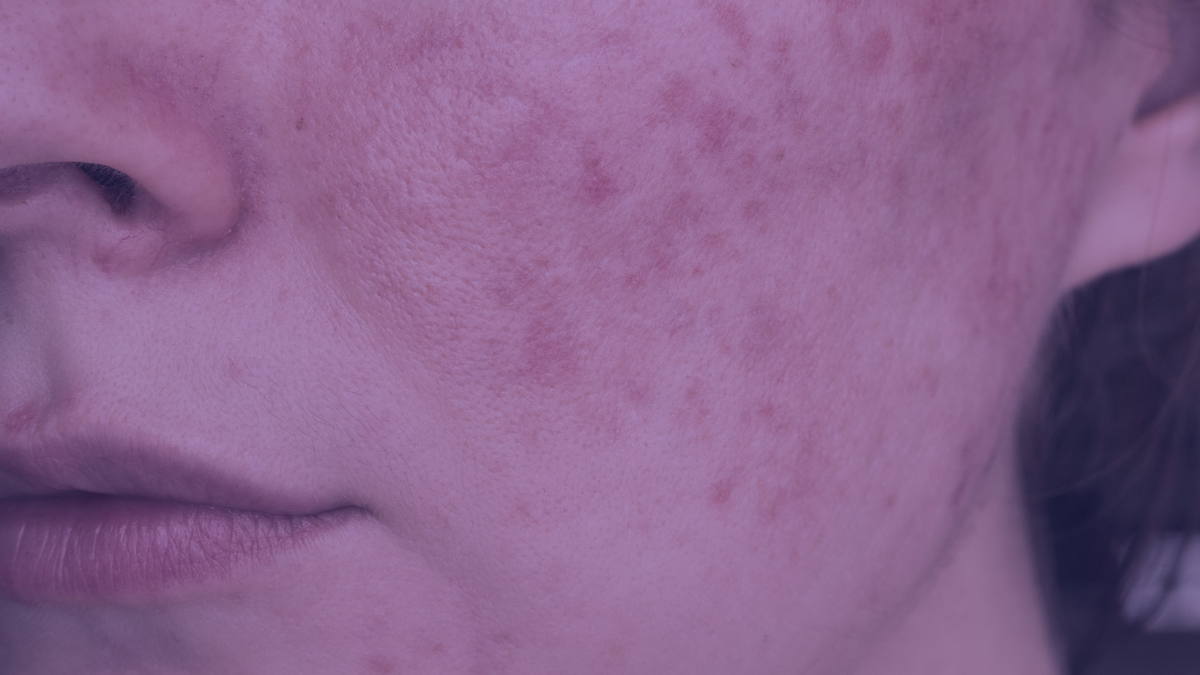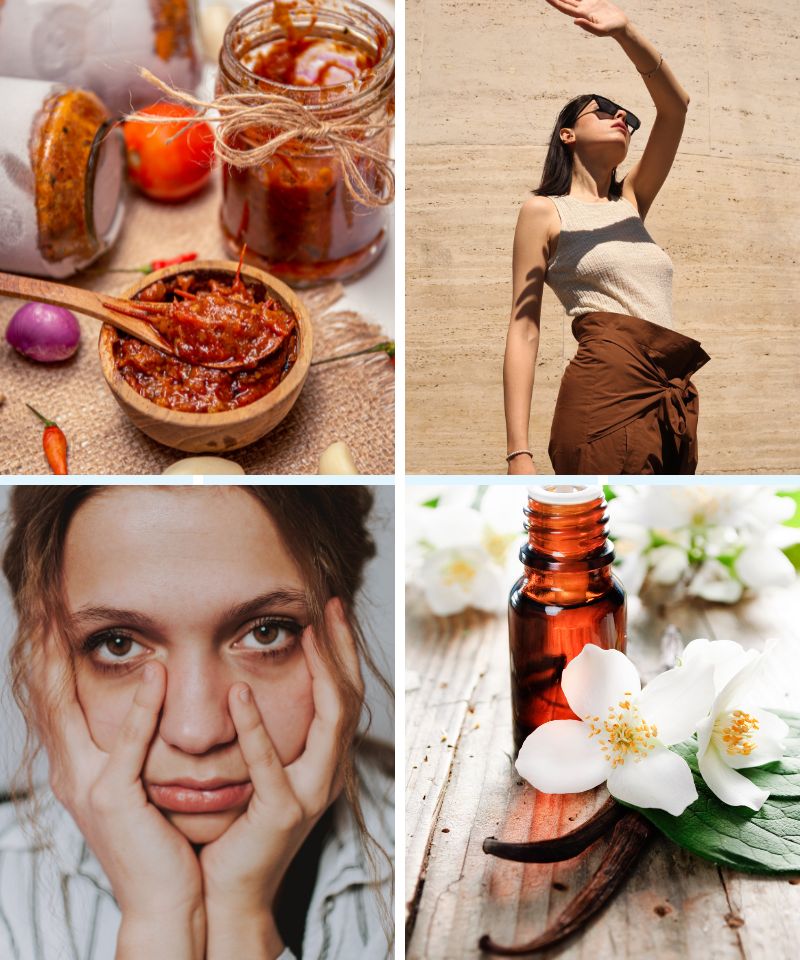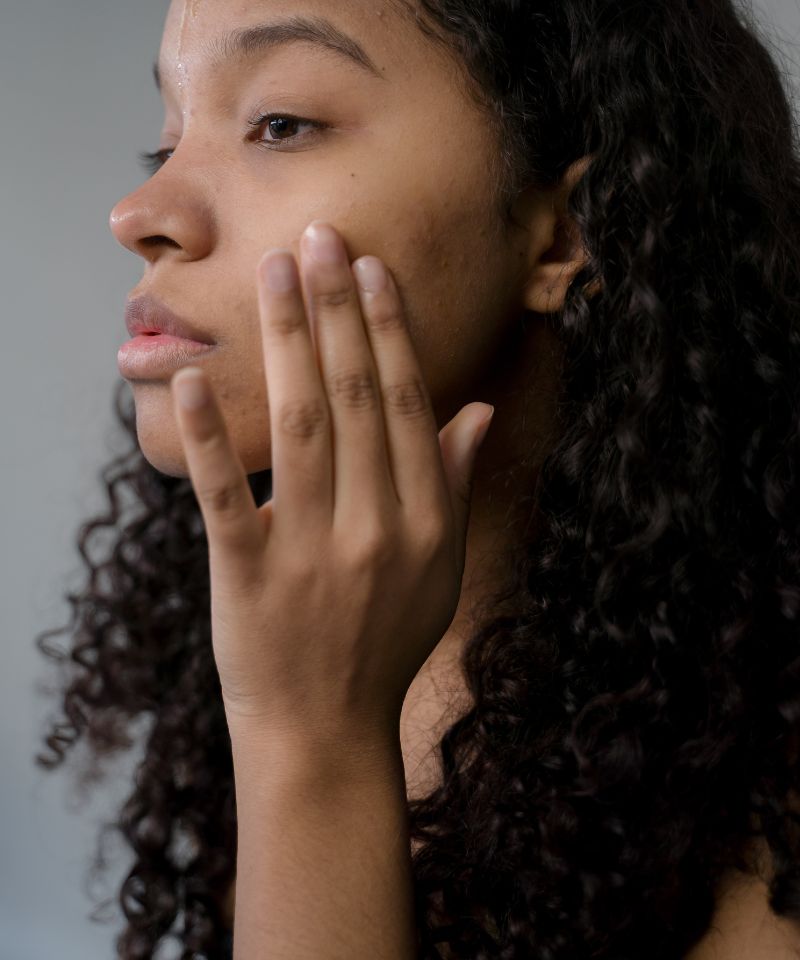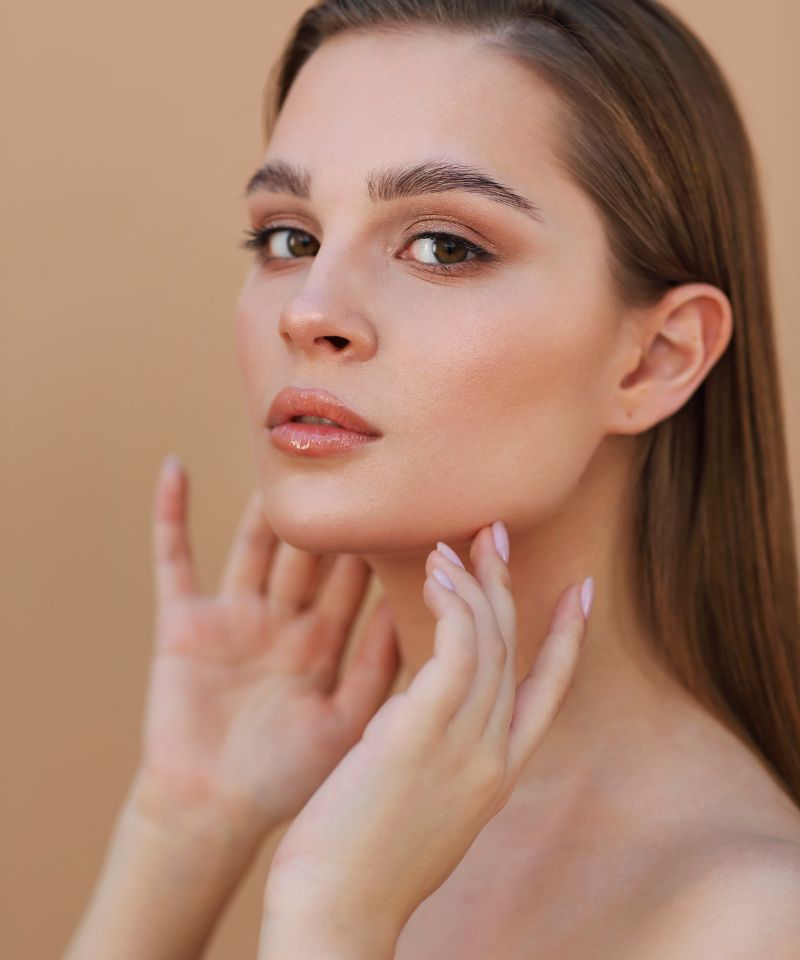Rosacea is acne’s redder, meaner, and harder-to-manage cousin.
This chronic skin condition affects millions of people worldwide and makes day-to-day life more challenging for many due to the uncomfortable symptoms it is known for.
However, with the right combination of treatments and lifestyle changes, you can take control of your rosacea and improve your quality of life.
Which is why, in this article, I will tell you everything you need to know about rosacea, what it is, why it flares up, how to avoid triggers, as well as how to manage this inflammatory condition so that you can live your best life symptom-free for as long as possible.

What is Rosacea?
Rosacea is a chronic hypersensitivity of the face and a relatively common skin condition typically recognized by flushing, redness, broken capillaries, and pimples in the central part of the face,
This condition usually affects middle-aged (30-50) women more than men, and it often runs in families. It also usually appears in people with fair skin and light eyes.
The exact cause of rosacea is unknown and is still being studied. However, it is assumed that a combination of diet, lifestyle factors, and mites may aggravate the inflammatory response.
The Different Types of Rosacea
There are actually four distinct types of rosacea that can affect people differently and trigger different symptoms, these are:
- Erythematotelangiectatic Rosacea (ETR).
- Papulopustular Rosacea.
- Phymatous Rosacea.
- Ocular Rosacea.
Erythematotelangiectatic Rosacea (ETR):
This type often manifests as redness and flushing in the central part of the face, with visible blood vessels, dry or sensitive skin, and rough and scaly areas.
Papulopustular Rosacea:
Also known as acne rosacea, this type is characterized by breakouts that resemble acne along with blushing and swelling, severe redness, and oily skin.
Phymatous Rosacea:
This type causes the skin to thicken and take on a bumpy texture, usually on the nose, chin, forehead, ears, and even eyelids.
Ocular Rosacea:
This impacts the eye area, causing redness, irritation, watery eyes, and sometimes swollen eyelids or styes, diminished vision, and eyelashes falling off.
It’s worth noting that most of these have similar symptoms and affect similar facial areas and that you could be dealing with more than one type of rosacea.
Additionally, symptoms can come and go or worsen or improve over time and may be different for everyone.
Therefore, if you have been consistently experiencing some of the symptoms mentioned, it is best to see a dermatologist and get properly diagnosed, as this will help you find the right maintenance for your condition and avoid triggers that could cause flare-ups.
Common Signs and Symptoms of Rosacea
While rosacea is usually a pretty distinct condition, not everyone experiences the same symptoms, especially in the beginning while the condition is developing.
Additionally, the severity of symptoms can vary from person to person, making this condition a little challenging to recognize and differentiate from similar conditions, such as acne.
Some of the main symptoms of rosacea include:
- Excessive oiliness.
- Broken blood vessels around the nostrils.
- Redness, which sometimes takes on a butterfly shape across the cheeks and nose.
- Solid papules and pustules.
- Stinging/burning of the skin and eye area.
Other symptoms can include:
- Dry skin.
- Swelling, especially around the eyes.
- Yellow-orange patches on the skin.
- Sore eyelids or crusts around roots of eyelashes – this could be blepharitis.
- Thickened skin, mainly on the nose (usually appears after many years of untreated rosacea.)
It’s also worth noting that rosacea symptoms can come and go, worsen over time if left untreated, and even change due to various factors.
Therefore, if you have experienced excessive oiliness during one flare-up, but your skin had become severely dry during another, this is still a symptom of rosacea that might’ve been influenced by different factors such as extreme weather temperatures, a change in your skincare routine, taking certain medications, etc., during the time of the flare-up.
8 Common Rosacea Triggers That Can Cause Flare-Ups

Rosacea is a condition that can easily be triggered by eating certain foods, extremes of temperature, and general lifestyle.
Although not necessarily causes, these are some of the things that rosacea is aggravated by:
Spicy Foods
Spicy foods such as red peppers, powders, and sauces can trigger or exacerbate rosacea flare-ups for many adults dealing with this condition.
This happens because hot peppers contain a chemical compound called capsaicin, which causes a rush of blood to the face and neck, which increases flushing, redness, and burning.
This inflammatory reaction leads to the activation of the innate system, triggering the production of T-cells, peptides, cytokines, and growth factors, which are components involved in our immune system’s ability to recognize and fight the presence of foreign bodies.
And while essential for our defense, when too many of these components are produced as a result of inflammation, it can cause a wide range of unwanted symptoms, including inflammatory skin conditions such as rosacea.
This inflammation can weaken the blood vessels over time, giving your skin a permanent red appearance and visible broken capillaries, which are the most distinct symptoms of rosacea.
Extreme Temperatures
Extreme hot and cold temperatures can trigger rosacea flare-ups in many adults.
In hot weather, the sun, heat, and humidity may lead to facial flushing, which means the blood vessels may dilate, making the skin more sensitive and prone to inflammation.
This prolonged state of inflammation and dilated blood vessels can eventually weaken the skin over time, leading to permanent redness.
On the other hand, extreme cold temperatures can cause a condition called vasoconstriction, where the blood vessels become compressed to protect our core temperature and prevent us from getting too cold.
This reaction is also common when we’re in a stressful situation, as it causes an increase in adrenaline and cortisol, leading to facial flushing.
Additionally, this reaction can also cause an increase in blood pressure for a short time, which can further weaken the blood vessels over time and eventually lead to permanent redness.
Therefore, extreme temperatures can cause a chain reaction that leads to rosacea symptoms such as redness, flushing, broken capillaries, and excessive skin dryness or oiliness, depending on your skin type.
Emotional Stress
With up to 90% of people with rosacea reporting a flare-up during a stressful period of their lives, it’s safe to say that stress can be a significant rosacea trigger in many adults.
And while the exact mechanism through which stress triggers rosacea is not fully understood, some studies suggest this may be due to stress activating the sympathetic nervous system, and the body’s response to this is to release stress hormones such as adrenaline and cortisol.
As previously mentioned, these hormones can cause a cascade of reactions, keeping inflammatory pathways turned on and triggering vasoconstriction, increased heart rate, and blood pressure, eventually leading to inflammation and rosacea symptoms.
Demodex Mites
Another possible rosacea trigger is the Demodex mites, which are tiny parasites that live on our skin and have been suggested as a potential culprit in multiple studies.
Demodex mites are almost unavoidable, but when their population overgrows, they may become a triggering factor for multiple inflammatory skin conditions, including acne, sores, and itchy bumps on the skin.
And while getting rid of them is impossible, some treatments can control their growth, such as washes, creams, gels, and ointments containing an acaricide, a pesticide that kills mites and other insect-like parasites.
However, these treatments may not be the most appropriate for people with rosacea, which is why in most cases, it is just best to keep the skin clean and moisturized to avoid exacerbating symptoms such as reddening of the face, itching, and burning, until the flare-up has settled down.
Retinoids
Retinoids are vitamin A derivatives available in over-the-counter options, such as retinol and adapalene, or prescription-strength options, such as tretinoin, that effectively improve skin tone, texture, acne, and signs of aging.
However, while retinoids will likely address any skin concern under the sun, using them comes with a few initial side effects.
One of these is irritation, which will be especially pronounced in those with sensitive skin and occurs when you introduce stronger retinoids, such as prescription-strength tretinoin, into your skincare routine without building up the skin’s tolerance with weaker retinoids first.
This irritation can cause discomfort, such as stinging, burning, and sensitive reactions.
However, irritations are also a sign of a compromised skin barrier, and when this is the case, it means that pathogens can easily penetrate inside the skin and cause an inflammatory reaction, leading to flare-ups and rosacea.
Harsh Exfoliation
Harsh exfoliation can be another rosacea trigger, as exfoliating too often with abrasive or acidic products can compromise the skin barrier and increase inflammation.
Exfoliation is an essential part of any skincare routine, as it helps remove dead skin cells and reveal a brighter complexion. However, this action can lead to potentially permanent side effects when overdone.
This happens because the dead skin cells on our skin’s surface are designed to keep moisture in the skin and act as barriers to protect us from environmental aggressors.
Therefore, constantly stripping them off will leave younger and immature skin cells from underneath to face the elements and be exposed to UV radiation, wind, pollution, and other potential pathogens.
However, these young and immature cells are not yet developed enough to protect us, so issues such as redness, sensitivity, irritation, and flares can start to develop.
Therefore, exfoliation should be done no more than 2-3 times a week, and even less if your skin is on the sensitive side, you are living in a cold and dry climate, and you are taking certain medications that may cause further skin dehydration.
On the other hand, if you are already dealing with rosacea, physical exfoliation is not recommended and should be replaced with gentler chemical exfoliants that work deeper into the skin instead of the skin’s surface, such as PHAs and BHA.
These alternatives will effectively keep pesky pimples at bay without triggering flare-ups.
Fragrance & Essential Oils
Fragrances and essential oils in beauty products are the number one cause of allergic contact dermatitis and have been linked to rosacea in multiple studies.
These are complex compounds made out of hundreds of ingredients, some natural, such as essential oils, others synthetic, and they can be potential allergens or irritants to those with sensitive skin.
While it’s unknown whether fragrances can cause the condition or just act as a trigger for flare-ups, it is advisable to stay away from them and opt for fragrance-free products when you can, as this will help you avoid discomfort.
Acne vs. Rosacea
Acne and rosacea are two inflammatory skin conditions that can sometimes manifest similar symptoms, such as redness, pustules, and papules.
However, they have different causes and require different management methods to keep them under control.
Acne is caused by an accumulation of oil and dead skin cells within the pores that attract bacteria to feed on the cellular debris, causing it to overgrow and trigger the immune system into sending white blood cells to fight the foreign pathogen.
Rosacea, on the other hand, is a chronic skin condition caused by an overactive immune system that sends inflammatory signals to the skin as if it were a foreign invader, causing redness and bumps even when no bacteria are involved.
Their appearance is also different, with acne lesions being non-inflammatory in the form of blackheads and whiteheads and inflammatory in the form of pustules, papules, and cysts, while rosacea usually manifests in bumps that can’t be squeezed out due to their inflammatory nature, and not comedones.
Finally, acne can be managed with a combination of topical treatments, such as benzoyl peroxide, exfoliating acids, and retinoids, along with oral medications, while rosacea usually requires a more proactive approach that includes lifestyle changes and a combination of gentle skincare products that won’t aggravate the skin further.
Rosacea in Darker Skin Tones

While redness, flushing, and blushing can be obvious signs of rosacea in those with light skin tones, this inflammatory condition can be harder to recognize in those with darker skin.
Darker skin tones can also develop rosacea, and here are some of the symptoms you should watch out for:
• A persistent warm feeling on your cheeks.
• Dry, swollen skin and patches of darker skin.
• A dusky brown discoloration to your skin.
• Acne-like breakouts that acne treatment won’t clear.
• Yellowish-brown, hard bumps around the mouth, eyes, or both.
• Burning or stinging when applying skincare products.
• Swelling and thickening skin on the nose, cheeks, chin, or forehead.
• Swollen, warm eyelids.
It’s worth noting that while the most obvious signs of rosacea can be harder to spot in those with dark skin, this condition can be managed with certain skincare practices and lifestyle changes.
How to Calm Rosacea Flare-Ups?
Here are a few quick and efficient solutions that will help you calm rosacea flare-ups in a pinch:
Apply Cold Compress
One of the fastest ways to calm rosacea flare-ups is to apply a cold compress to your face.
You can do this by soaking a clean face cloth in cold water and placing it over your face for five to ten minutes or even icing your face with ice wrapped in a clean cloth for a few minutes during the day.
This will help reduce redness, inflammation, and heat while relieving burning sensations.
Try a Stress Relief Technique
Stress can be a significant trigger for rosacea flare-ups, so it’s important to manage your stress levels to control your condition.
If rosacea symptoms occur immediately following a stressful situation, take some time to relax and practice quick stress relief techniques such as deep breathing or muscle relaxation.
On the other hand, if prolonged periods of stress are causing your symptoms to worsen, it might be worth considering more long-term solutions, such as getting a hobby, doing yoga, meditating, and even trying out counseling if needed.
Cool Off
Rosacea flare-ups can occur during strenuous physical activities like running or working out.
To avoid this, cool down after exercise and during breaks by applying a cold compress or taking a few moments to rest in a cool area.
Drink Cold Water
Drinking cold water while experiencing a flare-up can help cool down your body temperature and reduce inflammation.
Additionally, if you are dealing with frequent rosacea flare-ups, staying hydrated is important, as dehydration can trigger this inflammatory condition.
Apply a Fragrance-Free Moisturizer
Applying a fragrance-free moisturizer can help soothe your skin and reduce the appearance of redness.
Therefore, when trying to soothe a rosacea flare-up avoid moisturizers containing scented components such as essential oils and synthetic fragrances, and opt for calming ingredients such as aloe vera, green tea, panthenol, and ceramides to provide extra relief while strengthening your skin barrier and nourishing your skin during an inflammatory episode.
Apply Sunscreen
The sun’s rays can be a significant trigger for rosacea, as it causes an increase in body temperature, triggering flushing and redness on the skin.
Therefore, to avoid exacerbating your condition, apply sunscreen daily – even on cloudy days – as this will protect your skin from the UV rays and the cell-damaging free radicals in the environment that can irritate the skin and cause premature aging.
How to Prevent Future Rosacea Flare-Ups?

Going without rosacea flare-ups for months and even years is possible by tweaking certain lifestyle, diet, and skincare habits.
Therefore, here’s how to effectively prevent future rosacea flare-ups and manage the inflammatory condition:
Avoid Heat
Excessive heat is one of the fastest triggers for rosacea flare-ups as it increases blood flow to the face and causes redness and swelling.
Therefore, besides avoiding being outside during peak heat hours in summer, you should also avoid hot showers, steamy saunas, and even direct heat from hairdryers, straighteners, and hot towels.
Avoid Alcohol
Alcohol can cause an increase in facial blood vessels, leading to more pronounced redness and flushing.
Therefore, if you are trying to prevent rosacea flare-ups, it’s best to avoid alcohol or at least cut down your intake significantly.
Avoid Spicy Foods
Similar to alcohol, spicy foods can cause an increase in facial blood vessels and inflammatory cells, peptides, and growth factors, leading to increased redness and flushing.
Therefore, if you want to prevent further rosacea flare-ups, it’s best to avoid or reduce your intake of hot peppers, chili powder, curries, and other spicy dishes and opt for milder alternatives instead.
Check Medications for Side Effects
Medications such as steroids, sometimes prescribed for rosacea, can help calm flare-ups in the short term but may also cause rosacea to worsen in the long run.
This happens because steroids can thin the skin when applied too frequently and for a prolonged time without a break, leading to increased sensitivity and worsening of facial redness and making your skin dependent on the steroid for relief.
Additionally, some medications and supplements, such as vasodilators, beta beta-blockers, and vitamin B3 can also cause rosacea flare-ups, which is why it’s always a good idea to check medications or supplements for potential side effects before using them.
Avoid Certain Skincare Ingredients & Products
Certain skincare ingredients can irritate the skin and increase inflammation, making rosacea worse.
These include drying and irritating components such as alcohol, fragrance, and essential oils, particularly menthol, peppermint, camphor, lavender, eucalyptus oil., etc., along with astringents such as witch hazel and yerba mansa, which are commonly found in skin care products for oily and acne-prone skin, a condition that’s very frequently mistaken for rosacea.
Additionally, if you’re dealing with excessively oily skin and rosacea, it’s best to avoid potentially clogging ingredients such as heavy emollients, butters, oils, and silicones, as these may clog your pores and cause acne on top of your rosacea flare-ups.
Finally, when dealing with rosacea, avoid using physical exfoliants, such as scrubs and brushes, and opt for gentle chemical or enzymatic exfoliation instead.
This will help reduce inflammation while allowing you to gradually (yet effectively) buff away dead skin cells without irritating your skin further.
Have a Rosacea-Safe Skincare Routine
In order to minimize the environment of fits and starts that can exacerbate rosacea, it’s important to have a consistent, rosacea-safe skincare routine.
Here are the four essential steps you should follow when managing rosacea-prone skin:
Cleansing: Use a gentle cleanser once or twice a day. If your skin is on the oily side, you can opt for a gentle gel cleanser that doesn’t contain drying alcohol and irritating fragrance. On the other hand, if your skin is on the dry side, opt for a hydrating, cream-based cleanser that won’t strip your skin and exacerbate redness and flare-ups.
Soothing Serum: After cleansing, apply a calming facial serum. This step will help soothe redness and inflammation and reduce the appearance of blotches, bumps, and blemishes caused by rosacea. Look for formulas containing calming and anti-inflammatory ingredients such as panthenol, green tea extract, niacinamide, and Centella Asiatica extract, and avoid products that contain alcohol and fragrance.
Moisturizing: After cleansing and soothing with a serum, you need to apply a barrier-repairing moisturizer that will help strengthen your skin and protect it from further irritation. For best results, look for formulas containing hydrating and nourishing ingredients such as ceramides, shea butter, squalane, and hyaluronic acid.
Sun Protection: Applying sun protection is one of the most important steps in a rosacea-safe skincare routine. Sun exposure can worsen rosacea, increase the appearance of redness and bumps, and cause premature aging, which is why it’s essential to apply a broad-spectrum sunscreen with an SPF of at least 30 every day before heading outside.
In addition to these steps, it’s recommended to keep your skincare routine simple and not experiment with too many new products frequently or at once, as this will prevent irritations and future flare-ups and keep rosacea under control for longer.
Frequently Asked Questions
Can Rosacea Be Cured?
Rosacea is a chronic condition with periods of remission and relapses or flare-ups for which there’s no known cure.
However, some studies suggest that the average duration of the condition primarily affecting adult women is around nine years, meaning that for many, rosacea is a long-term rather than a lifetime condition.
Can Rosacea Be Prevented?
Rosacea can be prevented by taking certain measures, such as avoiding potential triggers, using the right skincare products, and following a healthy lifestyle, which is especially important if you are genetically predisposed to developing rosacea.
How Long Does a Rosacea Flare-Up Last?
A rosacea flare-up can occur suddenly when triggered by an external or internal factor and can last anywhere from 2-3 hours up to several days or even weeks if prolonged exposure to the trigger is present.
Can Rosacea Cause Acne?
Rosacea flare-ups can sometimes look like acne bumps and pustules; however, the two conditions aren’t the same despite the sometimes similar symptoms.
Can You Use Adapalene on Rosacea?
Adapalene can soothe rosacea bumps and pimples due to its anti-inflammatory effect. It can also prevent new breakouts and minimize the appearance of enlarged pores, redness, and scarring.
However, since adapalene is a retinoid, it can cause initial dryness, so it’s essential to start slowly and gradually build up your tolerance.
Additionally, when using adapalene on rosacea, you should have a complete skincare routine focused on hydrating and moisturizing your skin to prevent dryness and irritation.
Will Accutane Help Rosacea?
While Accutane isn’t the go-to maintenance option for rosacea, it has been proven effective in soothing severe cases of the inflammatory condition along with reducing the size and number of skin eruptions.
Therefore, if you are dealing with severe rosacea, Accutane may be an option to consider after consulting your dermatologist.
However, it’s important to note that the drug has a range of side effects, including mild symptoms such as dryness, peeling, and irritation, and more severe ones such as liver damage and birth defects.
So, weighing the risks versus benefits with your doctor before starting this intense medication is essential.

My name is Simone and I am a certified skin specialist. I created this website to teach my readers how to take great care of their skin and I also like to occasionally share my honest opinions on skincare products I’ve tried. You can learn more about me here.
